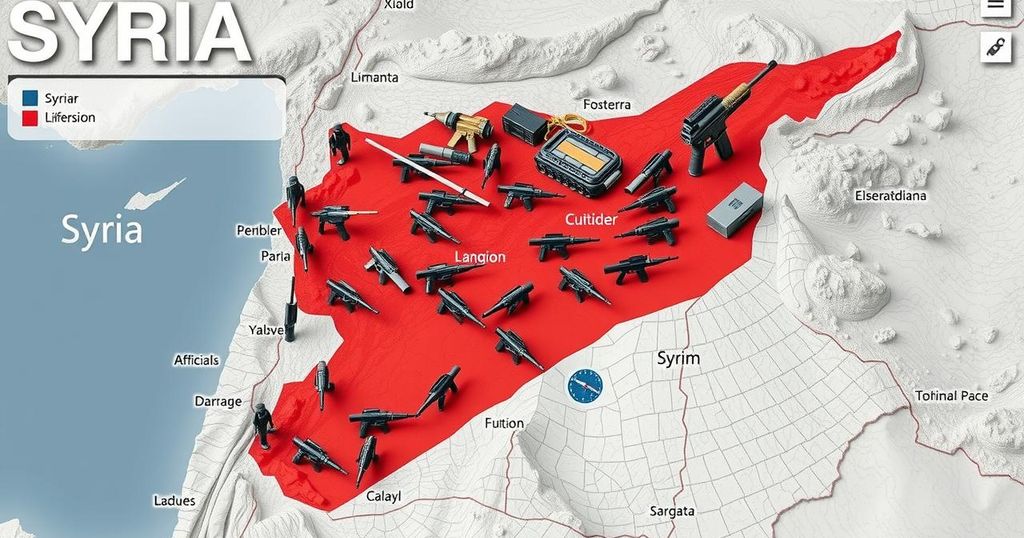Syria’s Civil War: Recent Developments and Implications
The Syrian Civil War has recently transformed as rebel forces overthrew the Assad regime. Triggered by the Arab Spring in 2011, prolonged conflict has been marked by intermittent calm. Recent breakthroughs by rebels led to the capture of key cities, culminating in the fall of Damascus. Prime Minister Jalali’s remarks about transitioning authority signal a significant regime change, while the fate of President Assad remains uncertain amidst unrest and celebrations in the streets.
The recent upsurge in hostilities in Syria culminated on a significant day when the rebel faction, Hayat Tahrir Al Sham (HTS), proclaimed the nation free from the Bashar Al Assad regime. The civil war, ongoing since 2011, saw a remarkable shift as rebel forces successfully advanced towards Damascus, capturing several pivotal cities en route. The Syrian Army, strained by the engagement in other conflicts involving Russia and Iran, appeared to dissolve in the face of the rebels’ offensive, ultimately leading to the capture of the capital. This development heralded a new chapter in Syria’s tumultuous history, marked by the potential collapse of a long-standing regime.
The origins of the Syrian Civil War trace back to 2011, arising as a reaction to the Arab Spring movement that inspired revolts against entrenched regimes across the Arab world. Despite appearing vulnerable initially, President Assad’s grip strengthened with intervention from Russia and Iran, which allowed his administration to withstand the pressures from various rebel groups. Although there were periods of relative tranquility in recent years, the latest surge of fighting indicates a re-escalation of hostilities, particularly following the rebels’ capture of Aleppo, which signified a major victory for opposition forces.
The recent rebel advance saw swift and strategic captures of significant cities, including Daraa, Quneitra, Suwayda, and Homs, leading up to their entrance into Damascus. This momentum facilitated the rebels in breaching the Saydnaya prison, liberating numerous political prisoners previously held by the Assad regime. As they penetrated the capital, reports emerged suggesting that President Assad may have fled the country in anticipation of the coming takeover, and his current location remains uncertain.
Prime Minister Mohammad Jalali expressed the government’s willingness to transition power to opposition forces, emphasizing the importance of preserving public properties during this tumultuous period. HTS subsequently declared the liberation of Syria and urged fighters to safeguard government infrastructure, establishing a provisional leadership under Jalali as a prelude to formal governance transfer. The scenes of celebration among civilians, including the removal of statues venerating the Assad dynasty, underscore the momentous nature of this remarkable shift.
In retrospect, the events unfolding in Syria reflect a capstone moment in a decade-long ordeal marked by war and devastation. The change in leadership, culminating in the rebels toppling a regime that has dominated the country for over fifty years, invites new possibilities for a nation long marred by conflict. Yet, the uncertain dynamics of regional power and the potential resurgence of extremist groups like ISIS present continued challenges as Syria embarks upon its next chapter.
The Syrian Civil War has its roots in the wave of protests that swept through the Arab world in 2011, inspiring citizens across multiple nations to challenge their governments. Initially facing relatively little opposition, President Bashar Al Assad’s regime received significant support from foreign powers such as Russia and Iran, allowing it to maintain control through various military and political means. This external support helped keep opposition factions at bay for several years, but recent developments suggest a reconfiguration of alliances and power dynamics that call into question the sustainability of Assad’s rule in the face of renewed rebel offensives. Following the recent capture of various cities and ultimately Damascus, the political landscape in Syria is poised for dramatic changes as the opposition seeks to establish a new governance framework.
In conclusion, the recent developments in Syria signify a pivotal moment in the country’s ongoing civil war, with the successful advance of rebel forces leading to the potential toppling of the Assad regime. As the situation evolves, the new power dynamics and the potential for a leadership transition create both hope and uncertainty. The international community will undoubtedly watch closely as Syria navigates this unprecedented change, and the ability of the new leadership to consolidate power amidst the volatile backdrop of the region’s geopolitics remains to be seen.
Original Source: www.hindustantimes.com




Post Comment